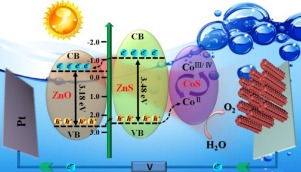Applied Catalysis B: Environment and Energy ( IF 20.2 ) Pub Date : 2017-12-26 , DOI: 10.1016/j.apcatb.2017.12.065 Jian Zhou , Awu Zhou , Lun Shu , Ming-Cheng Liu , Yibo Dou , Jian-Rong Li

|
Photoelectrochemical (PEC) water splitting offers a promising way for producing clean and renewable hydrogen fuel, but how to improve the solar conversion efficiency is still a challenge. Herein, the sulfurization of metal-organic frameworks (MOFs) onto the semiconductor ZnO to fabricate heterojunctions for PEC water oxidation was proposed. Cellular [email protected], [email protected], and [email protected]/CoS heterostructured catalysts thus obtained through the direct sulfurization of [email protected] ([email protected]) composites exhibit excellent PEC performances. Particularly, the [email protected]/CoS represents a largely improved photoconversion efficiency (0.65% at 0.14 V) and photocurrent density (2.46 mA cm−2 at 0.6 V) under full spectrum illumination, outperforming those of previously reported ZnO-based catalysts in neutral medium. Clearly, their special cellular structure affords rich exposed active sites and long incident photon transport pathway for well light absorption. And, the suitable band matching with strong electronic coupling in the integrated heterojunctions facilitates the effective electron-hole separation. Furthermore, CoS acting as co-catalyst can speed up the hole transfer and simultaneously participate in the surface water oxidation, which leads to the lower oxygen evolution barrier for [email protected] and [email protected]/CoS. This MOF-derivative decoration approach could be expanded to fabricate other composite photoanodes for a variety of energy storage and conversion applications.
中文翻译:

通过将MOF硫化到ZnO上制备的细胞异质结,用于高效光电化学水氧化
光电化学(PEC)分解水提供了一种生产清洁和可再生氢燃料的有前途的方法,但是如何提高太阳能转换效率仍然是一个挑战。在此,提出了将金属有机骨架(MOF)硫化到半导体ZnO上以制造用于PEC水氧化的异质结的方法。通过直接硫化[受电子邮件保护的]([受电子邮件保护的])复合物而获得的蜂窝状[受电子邮件保护的],[受电子邮件保护的]和[受电子邮件保护的] / CoS异结构催化剂表现出优异的PEC性能。特别地,[受电子邮件保护] / CoS代表了大大提高的光转换效率(0.14 V时为0.65%)和光电流密度(2.46 mA cm -2)在0.6 V电压下)在全光谱照明下,表现优于先前报道的中性介质中基于ZnO的催化剂。显然,它们特殊的细胞结构提供了丰富的暴露活性位点和长入射光子传输途径,以实现良好的光吸收。并且,在集成异质结中具有强电子耦合的合适能带匹配促进了有效的电子-空穴分离。此外,充当助催化剂的CoS可以加快空穴的转移并同时参与地表水的氧化,从而降低了[受电子邮件保护的]和[受电子邮件保护的] / CoS的氧气释放屏障。这种MOF衍生的装饰方法可以扩展以制造用于各种能量存储和转换应用的其他复合光阳极。











































 京公网安备 11010802027423号
京公网安备 11010802027423号